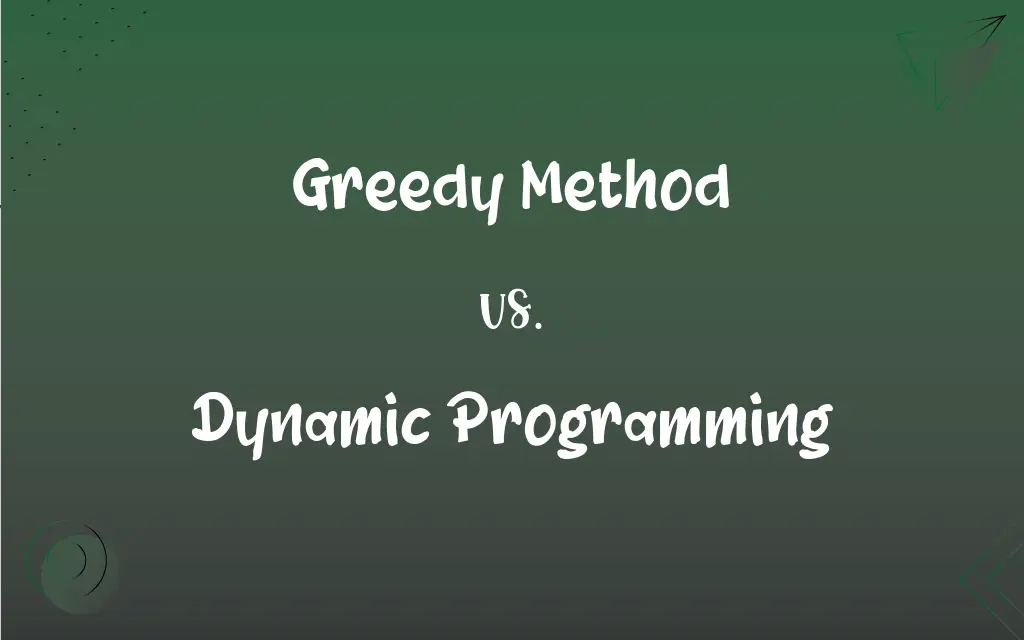Greedy Method vs. Dynamic Programming: What's the Difference?
Edited by Aimie Carlson || By Janet White || Published on February 23, 2024
The greedy method makes the optimal choice at each step, while dynamic programming breaks the problem into smaller subproblems and solves them once.

Key Differences
The greedy method is a problem-solving approach that makes the best possible choice at each stage with the hope of finding the global optimum. In contrast, dynamic programming breaks the problem down into smaller, manageable subproblems and solves each just once, storing their solutions to avoid repeated work.
Greedy algorithms are generally simpler and faster, as they make decisions based on local optimization without considering the bigger picture. Dynamic programming, however, considers the entire problem by solving each subproblem and using these solutions to construct a solution to the original problem.
The greedy method does not guarantee an optimal solution for all problems, as the local optimum at each step may not lead to a global optimum. Dynamic programming is used when the problem has overlapping subproblems and optimal substructure, ensuring an optimal solution.
Greedy algorithms are often easier to conceptualize and can be more efficient in terms of memory. Dynamic programming can be more computationally intensive and require more memory since it stores the solutions of subproblems.
The greedy method is suitable for problems like finding the minimum spanning tree or the shortest path in a graph. Dynamic programming is used in problems like the knapsack problem, Fibonacci number calculation, or shortest path problems where the greedy method doesn’t yield an optimal solution.
ADVERTISEMENT
Comparison Chart
Approach
Local optimum at each step
Global optimum using solved subproblems
Complexity
Generally simpler and faster
More complex, but thorough
Optimal Solution Guarantee
Not always guaranteed
Guaranteed under certain conditions
Memory Efficiency
More memory efficient
Less memory efficient
Suitable Problems
Minimum spanning tree, shortest path
Knapsack problem, Fibonacci numbers
ADVERTISEMENT
Greedy Method and Dynamic Programming Definitions
Greedy Method
An approach that does not reconsider choices once they are made.
The greedy method was applied to the traveling salesman problem but didn’t guarantee the shortest route.
Dynamic Programming
An algorithmic technique that combines the solutions of smaller problems to solve a larger problem.
Dynamic programming was applied to efficiently solve the matrix chain multiplication problem.
Greedy Method
A problem-solving strategy focusing on immediate, best-choice decisions.
The greedy method efficiently solved the activity selection problem.
Dynamic Programming
An approach that solves each subproblem only once and stores the results to avoid repeated computations.
In dynamic programming, the knapsack problem was solved by storing and reusing the results of smaller subproblems.
Greedy Method
An algorithmic approach that makes the locally optimal choice at each step.
The greedy method was used to solve the coin change problem.
Dynamic Programming
A method of solving complex problems by breaking them into simpler subproblems.
Dynamic programming was used to compute the Fibonacci sequence efficiently.
Greedy Method
A technique that hopes to find the global optimum by choosing the best option at each step.
In job scheduling, the greedy method schedules the job that finishes earliest.
Dynamic Programming
A technique used when a problem has overlapping subproblems and optimal substructure.
Dynamic programming found the shortest path in a graph where each subpath was also the shortest.
Greedy Method
A simple, intuitive algorithm design technique often used for optimization problems.
For the shortest path problem, a greedy method was used to select the nearest unvisited node at each step.
Dynamic Programming
A strategy that is often more efficient than naive recursion for problems with repeated subproblems.
The rod cutting problem was optimally solved using dynamic programming to avoid redundant calculations.
FAQs
Can the greedy method solve the knapsack problem?
It can solve the fractional knapsack problem but not the 0/1 knapsack problem optimally.
Do greedy algorithms use recursion?
They rarely use recursion, focusing instead on iterative solutions.
Is the greedy method used in network routing?
Yes, it's used in certain routing algorithms for efficiency.
What is the key characteristic of problems suitable for dynamic programming?
Problems with overlapping subproblems and optimal substructure.
What types of problems are best solved by the greedy method?
Problems where local optimum choices lead to a global optimum, like the shortest path.
Is the greedy method always faster than dynamic programming?
Generally, yes, but it may not always provide an optimal solution.
How does dynamic programming improve over naive recursion?
By storing the results of subproblems to avoid redundant calculations.
Are there different approaches within dynamic programming?
Yes, including top-down (memoization) and bottom-up approaches.
Can dynamic programming be used in real-time systems?
It can be challenging due to its higher computational requirements.
How do greedy and dynamic programming differ in problem-solving?
Greedy makes local optimal choices; dynamic programming solves subproblems for a global optimum.
Is dynamic programming applicable to all optimization problems?
No, it's best for problems with specific properties like overlapping subproblems.
How does memoization work in dynamic programming?
It stores the results of expensive function calls and returns the cached result when the same inputs occur again.
Is a greedy algorithm easier to implement than dynamic programming?
Generally, yes, due to its straightforward approach.
Can greedy algorithms be used for sorting?
Certain sorting algorithms, like selection sort, are greedy.
How does dynamic programming handle large data sets?
It can handle large data sets but may require significant memory.
Is dynamic programming overkill for simple problems?
Yes, for simple problems, simpler algorithms may be more efficient.
How do you choose between greedy and dynamic programming?
Analyze the problem's characteristics, like optimal substructure and overlapping subproblems, to decide.
Can dynamic programming be used for graph problems?
Yes, especially for problems like shortest paths in weighted graphs.
Are greedy algorithms used in machine learning?
They are used in certain scenarios, like decision tree classifiers.
Do greedy algorithms provide approximate solutions?
Sometimes, they provide approximate solutions when an exact solution is costly.
About Author
Written by
Janet WhiteJanet White has been an esteemed writer and blogger for Difference Wiki. Holding a Master's degree in Science and Medical Journalism from the prestigious Boston University, she has consistently demonstrated her expertise and passion for her field. When she's not immersed in her work, Janet relishes her time exercising, delving into a good book, and cherishing moments with friends and family.
Edited by
Aimie CarlsonAimie Carlson, holding a master's degree in English literature, is a fervent English language enthusiast. She lends her writing talents to Difference Wiki, a prominent website that specializes in comparisons, offering readers insightful analyses that both captivate and inform.































































